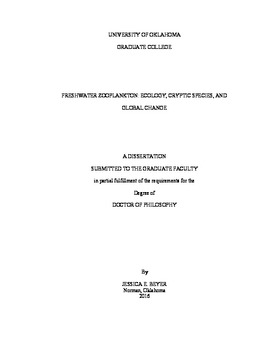| dc.description.abstract | Modern threats to freshwater biota include anthropogenic eutrophication and invasive species, both of which may impact biodiversity. My four chapters focus on different aspects of these global changes. In Chapters 1 and 2, I focus on the effects of the harmful algal blooms caused by anthropogenic eutrophication on native freshwater grazers. In Chapter 3, I focus on a feature that complicates our understanding of diversity of zooplankton and other animals: cryptic species. In Chapter 4, I examine the environmental factors associated with abundance and morphology of an invasive zooplankter. Taken together, my work shows the myriad of effects and important considerations in studying the effects of global change on freshwater zooplankton.
In my first two chapters, I address the effects of harmful algal blooms that occur as a result of anthropogenic eutrophication. I tested how exposure to the toxigenic cyanobacteria Microcystis aeruginosa affects the common rotifer Brachionus calyciflorus, both within and across generations. In Chapter 1, using a laboratory experiment, I found evidence of carry over effects, meaning that individuals exposed to high amounts of good food (Chlamydomonas sp.) could later withstand exposure to Microcystis better than individuals that were fed low amounts of food during early development. Thus, as blooms of cyanobacteria become longer in duration and more frequent, rotifer populations may experience compounding negative effects. Further, I found that offspring produced by mothers fed Microcystis were of lower quality (measured as ovary:body ratio) and, if the mother had initially been fed a low amount of food, were also significantly smaller. However, offspring produced by mothers exposed to Microcystis after having been reared on high amounts of good quality food produced significantly larger offspring. This led me to hypothesize that the larger size of these offspring could be adaptive under poor food conditions.
In Chapter 2, I tested this hypothesis by raising mothers in either Microcystis or Chlamydomonas, and then raising their offspring in either of the two treatments. Based on the maternal match hypothesis, I predicted that offspring would have higher population growth rates if reared on the same diet as their mother. However, the results of my experiment did not support this hypothesis. Instead, I found that offspring produced by mothers reared on Chlamydomonas had higher fecundity and survival than those produced by mothers reared on Microcystis, regardless of the offspring diet. The results of this chapter, taken together with those of Chapter 1, suggest that blooms of toxigenic cyanobacteria may have more extensive negative effects on grazer populations than have been previously suggested, based on single generation studies.
In Chapter 3, I consider patterns in the discovery of cryptic species across animal taxa. While earlier work had suggested that cryptic species are evenly distributed across taxa, I find significant variation in the number of cryptic species discoveries across both animal phyla and insect orders. In using a model comparison approach, I found that the best predictors of the frequency of cryptic species were those associated with research intensity, including human health association and taxonomic research effort. These results have consequences for our study of diversity in a changing world, as we can only fully understand the effects of global change on diversity when the quantification of diversity includes cryptic species and is equivalent across taxa.
In Chapter 4, I investigated the drivers of abundance and morphology of an invasive zooplankter, Daphnia lumholtzi, twenty years after its initial introduction to lakes in the United States. I found that the single best predictor of D. lumholtzi abundances within Lake Texoma, OK-TX, was the abundance of cyanobacteria. Additionaly, patterns in the scaling relationships of head and tail spines led me to suggest that there is seasonal predation pressure by a gape-limited predator on D. lumholtzi within this subtropical reservoir. Both the abundance and morphology of D. lumhotlzi are associated with patterns in native biota.
Blooms of cyanobacteria will play a large role in structuring population dynamics of native zooplankton as climate change continues to favor increasing frequencies and durations of these blooms. Further, our understanding of the effects of these blooms on diversity and ecosystem function will be filtered through our understanding of this diversity. Molecular tests of cryptic speciation, particularly in less studied groups, will continue to be of the utmost importance. | en_US |
